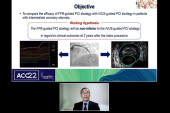FAVOR III China: Early Gains of QFR in PCI Persist to 2 Years
Reductions in MACE were most pronounced in patients whose treatment plan was changed based on QFR assessment.

BOSTON, MA—The advantage of quantitative flow ratio (QFR) guidance may persist long term, with better clinical outcomes out to 2 years in patients in whom the strategy is used prior to PCI versus those whose treatment is based on standard angiographic guidance, the FAVOR III China study finds.
In his recorded presentation here at TCT 2022, lead investigator Lei Song, MD, PhD (Fuwai Hospital, Beijing, China), showed that the relative hazard of 2-year MACE (a composite of death from any cause, MI, or ischemia-driven revascularization) was reduced by 34% with the QFR-guided strategy, and that the benefits of QFR continued to accrue over time. In landmark analyses, there was a consistent reduction in MACE rates between 1 and 2 years (HR 0.65; 95% CI 0.46-0.91) and between 0 and 1 year (HR 0.65; 95% CI 0.51-0.83).
Similar to the 1-year results, presented at last year’s TCT, the lower MACE rates at 2 years were driven primarily by fewer procedural and nonprocedural MIs in the QFR-guided group (4.0% vs 6.8%; P = 0.0002), as well as less ischemia-driven revascularization (4.2% vs 5.8%; P = 0.02). Rates of all-cause and CV mortality were similar between treatment arms.
“The reductions in MACE were most pronounced in patients in whom QFR assessment-directed changes in the pre-PCI revascularization plan and in whom a QFR-concordant PCI strategy was performed,” Song said in his presentation.
Davide Capodanno, MD, PhD (University of Catania, Italy), who was a panelist in the late-breaking session, told TCTMD that the study is more evidence that anatomy alone is not the best guide for stenting.
“This is a part of a set of studies that show the same message, which is that when we decide which lesions have to be stented, we have to be careful that they also produce some kind of effect on the downstream myocardium,” he said. Capodanno added that data from this study, and others involving fractional flow reserve (FFR), FFR-CT, and instantaneous wave-free ratio (iFR), send a consistent message that “you should be careful not to place too many stents [as an overreaction] to the lesions.”
While many operators are not familiar with QFR or don’t have access to it, some worry that operators could rely on it too much.
“I think it’s got tremendous attraction and possibilities, but one of the concerns I have is that . . . the need for careful, technique-driven angiography goes by the wayside and automates the process, perhaps, a bit too much,” Eric A. Cohen, MD (Sunnybrook Health Sciences Centre, Toronto, Canada), commented in a media briefing.
To TCTMD, Song said although the study patients had low anatomical complexity, QFR likely can be applied to almost all-comers presenting for PCI. “In the real world, I think maybe 10 to 15% cannot receive QFR based on this technique,” he commented.
Long-term Impact of Lesion Selection Methods
FAVOR III China randomized patients (mean age 63 years; 70% men) to a QFR-guided (n = 1,913) or angiography-guided strategy (n = 1,912) if they had at least one lesion with a diameter stenosis of 50% to 90% and a reference vessel diameter of at least 2.5 mm. Vessels that were intended to be treated were identified by operators prior to randomization.
With the QFR-guided strategy, all coronary arteries were measured and PCI was performed if QFR was ≤ 0.80 or diameter stenosis was > 90%. Operators performed the simulation in real time using 3D reconstruction and computational fluid dynamics from the angiogram. Two imaging runs were done and those data were transmitted to the AngioPlus system (Pulse Medical Imaging Technology) by a local network of sites for QFR computation. The planned strategy was changed because of QFR results in nearly one-quarter of patients, with deferral of at least one vessel originally intended for PCI in 19.6% of those in the QFR arm and 5.2% in the angiography arm, while treatment of at least one vessel not intended for PCI occurred in 4.4% and 1.5%, respectively.
It's reassuring to see that in the end that there is no harm in deferring these lesions, which is the key message. Davide Capodanno
At 2 years, 8.5% of patients in QFR arm and 12.5% in the angiography-guided arm had a MACE (HR 0.66; 95% CI 0.54-0.81). When procedural MIs were excluded, the MACE rate was 5.8% versus 8.8% (HR 0.65, 95% CI 0.51-0.83). All nonprocedural MIs were spontaneous, with 40 seen before 1 year and 35 between years 1 and 2. Song and colleagues say none of these were related to unplanned revascularization procedures over follow-up.
Ischemia-driven revascularization was performed in 189 patients over the 2-year follow-up. In 38 instances where revascularization was needed for rapid progression, all had baseline QFR > 0.80.
Although MACE rates were lower in the QFR group than the angiography group regardless of whether QFR changed treatment strategy, lower rates of MACE occurred in those in whom the preplanned PCI strategy was modified (P for interaction = 0.009). As Song showed in his presentation, rates of MACE in patients with no changes to PCI strategy were 8.4% at 2 years in the QFR group versus 11.7% in the angiography group (HR 0.70; 95% CI 0.56-0.88), while in the group with strategy changes, MACE rates were 8.8% in the QFR group versus 23.5% in the angiography group (HR 0.34; 95% CI 0.21-0.22).
The investigators note that one of the limitations of the study is intraprocedural bias, given the knowledge by PCI operators of study-group assignments. There also remains uncertainty about whether the advantage of QFR will extend through longer-term follow-up. A follow-up of 5 years is planned.
Song said it is unclear if the results are generalizable to imaging systems other than the one used in the study to assess QFR.
For Capodanno, the data from the study help elucidate the way in which QFR potentially could help operators perform PCI smarter by adding important information to angiographic assessment. “When you defer the lesion, the technology is telling you not to treat it. It's reassuring to see that in the end that there is no harm in deferring these lesions, which is the key message,” he added.
L.A. McKeown is a Senior Medical Journalist for TCTMD, the Section Editor of CV Team Forum, and Senior Medical…
Read Full BioSources
Song L, Xu B, Tu S, et al. Angiographic quantitative flow ratio-guided coronary intervention: two-year outcomes of the FAVOR III China trial. J Am Coll Cardiol. 2022;Epub ahead of print.
Disclosures
- Song reports no relevant conflicts of interest.





Comments